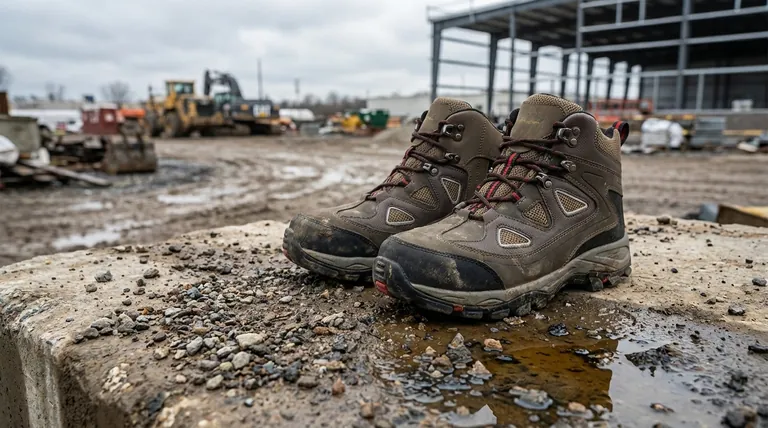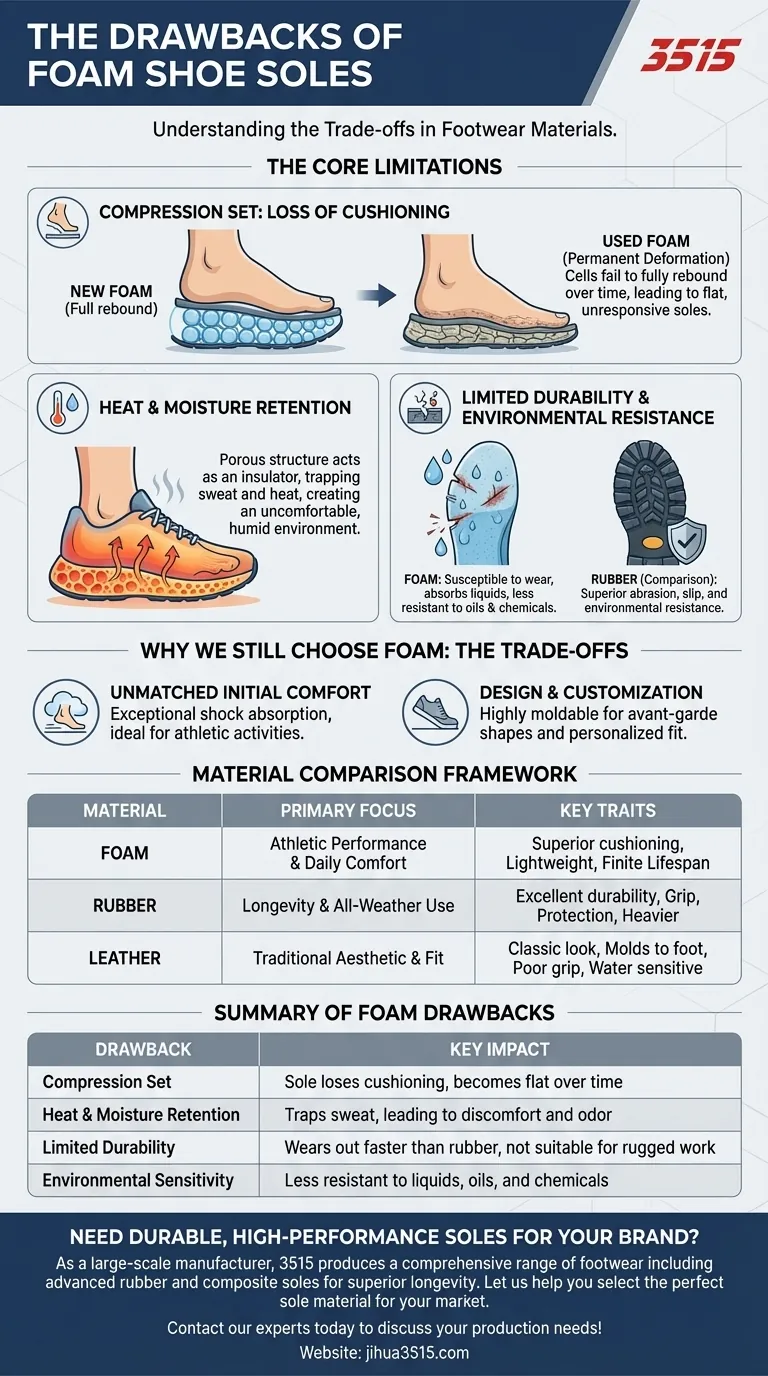At its core, the primary drawbacks of foam shoe soles are a lack of durability, poor heat and moisture management, and a finite lifespan for their cushioning. While celebrated for initial comfort, foam's cellular structure is prone to breaking down under repeated stress and trapping sweat, leading to discomfort and diminished performance over time.
While foam soles provide exceptional shock absorption and lightweight comfort, this comes at a direct trade-off. Their inherent softness is also their greatest weakness, leading to a shorter functional lifespan compared to materials like rubber or leather.

The Core Limitations of Foam Soles
To understand if foam is right for you, it's essential to examine its specific weaknesses. These issues stem directly from the physical properties that also make it comfortable.
Heat and Moisture Retention
The porous, airy structure that makes foam an excellent cushion also makes it an effective insulator.
This structure traps heat and sweat generated by your foot during activity. Over time, this can lead to an uncomfortable, humid environment inside the shoe, contributing to odor and blisters.
The Durability Problem: Compression Set
The most significant drawback is foam's tendency to permanently deform under pressure, a phenomenon known as compression set.
With every step, the foam cells compress to absorb impact. Over hundreds of thousands of cycles, these cells fail to fully rebound, causing the sole to harden and lose its "bouncy" quality.
This is why a running shoe that felt great out of the box will feel flat and unresponsive after several hundred miles of use.
Limited Environmental Resistance
Unlike dense rubber or treated leather, many foams are less resistant to the elements.
They can absorb liquids more easily, and they lack the rugged durability needed for demanding work environments where resistance to oil, chemicals, or punctures is required.
Understanding the Trade-offs: Why We Still Choose Foam
Given these drawbacks, the prevalence of foam soles speaks to their significant advantages in specific contexts. The choice is always about balancing competing priorities.
Unmatched Initial Comfort
No other common sole material matches foam's ability to absorb shock. This makes it an ideal choice for activities like walking and running, where reducing impact on joints is a primary concern.
Design and Customization
Foam is highly moldable, allowing for avant-garde designs and shapes that would be impossible with traditional materials.
Furthermore, specialized variants like memory foam can adapt to the unique contours of a wearer's foot, offering a degree of personalized arch support.
The Contrast with Other Materials
Foam's limitations are clearer when compared to alternatives.
Rubber is far more durable and slip-resistant but is also heavier and less breathable. Leather is classic and molds to the foot but offers poor grip and is easily damaged by water. Wood is extremely rigid and offers no flex or cushioning.
Making the Right Choice for Your Goal
The ideal sole material depends entirely on its intended purpose. Use this framework to guide your decision.
- If your primary focus is athletic performance or daily comfort: Foam is an excellent choice for its superior cushioning and lightweight feel, but be prepared to replace the shoes as the cushioning degrades.
- If your primary focus is longevity and all-weather use: A dense rubber or composite sole will provide far better durability, protection, and grip for work or outdoor activities.
- If your primary focus is a traditional aesthetic and a fit that improves over time: High-quality leather soles are the standard for formal footwear, offering a classic look and the ability to mold to your foot.
Ultimately, understanding the inherent trade-offs of each material is the key to selecting footwear that truly serves your needs.
Summary Table:
| Drawback | Key Impact |
|---|---|
| Compression Set | Sole loses cushioning, becomes flat over time |
| Heat & Moisture Retention | Traps sweat, leading to discomfort and odor |
| Limited Durability | Wears out faster than rubber, not suitable for rugged work |
| Environmental Sensitivity | Less resistant to liquids, oils, and chemicals |
Need durable, high-performance soles for your brand or bulk order? As a large-scale manufacturer, 3515 produces a comprehensive range of footwear for distributors, brand owners, and bulk clients. Our production capabilities encompass all types of shoes and boots, including advanced rubber and composite soles designed for superior longevity and all-weather performance. Let us help you select the perfect sole material for your target market. Contact our experts today to discuss your production needs!
Visual Guide

Related Products
- Safety Footwear Wholesale Manufacturer for Custom OEM/ODM Production
- Wholesale Comfort Leather Business Shoes with Dial Lacing System
- Premium KPU Injection Athletic Style Safety Shoes
- Wholesale Lightweight Tactical Boots with Dial Closure OEM & Bulk Orders
- Premium Safety Shoes with Rotating Buckle Safety Sneakers
People Also Ask
- What do heavy duty boots do? Protect Your Feet in Demanding Work Environments
- What are the cultural perspectives on wearing shoes in the house? A Guide to Home Etiquette & Hygiene
- What cultural and environmental considerations are tied to wearing shoes indoors? Balance Hygiene, Tradition, and Foot Health
- What are OSHA approved shoes? Understanding the Correct Standards for Workplace Safety
- Is it normal to wear shoes in the house? A Guide to Hygiene, Comfort & Culture



















